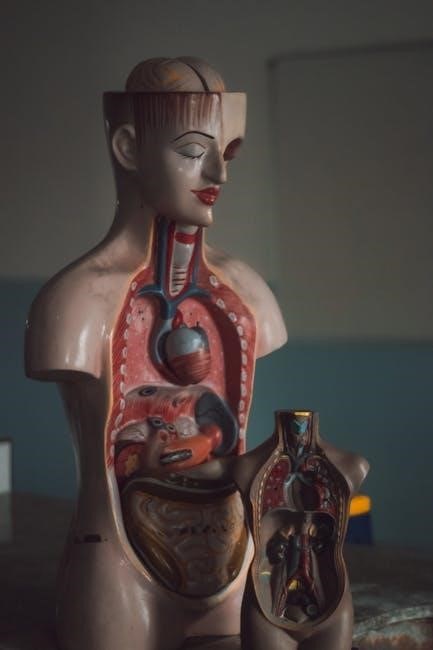The cardiovascular system, also known as the circulatory system, is a vital network of organs and vessels transporting blood throughout the body, supplying oxygen and nutrients while removing waste.
1.1 Overview of the Cardiovascular System
The cardiovascular system is a closed circulatory network consisting of the heart, blood vessels, and blood. It transports oxygen, nutrients, and hormones to cells while removing carbon dioxide and waste. The system includes arteries, veins, and capillaries, ensuring efficient blood flow. It works in tandem with the lymphatic system to maintain fluid balance and overall physiological homeostasis, essential for sustaining life and bodily functions.
1.2 Importance of the Cardiovascular System in Human Physiology
The cardiovascular system is crucial for delivering oxygen, nutrients, and hormones to cells while removing waste products, enabling cellular function and overall bodily operations. It maintains homeostasis, supports immune function, and regulates body temperature, ensuring proper organ and tissue performance. Its efficiency directly impacts energy levels, physical performance, and overall health, making it indispensable for human survival and physiological balance.

Anatomy of the Cardiovascular System
The cardiovascular system comprises the heart, blood vessels, and blood, forming a closed circuit essential for circulation. It includes arteries, veins, capillaries, and lymphatic vessels.
2.1 Structure of the Heart
The heart is a muscular organ divided into four chambers: two atria and two ventricles. It features valves ensuring unidirectional blood flow, an endocardium lining, myocardium muscle layer, and a protective pericardium. This structure efficiently pumps blood through the circulatory system, maintaining life-sustaining functions and overall cardiovascular health.
2.2 Types of Blood Vessels: Arteries, Veins, and Capillaries
Arteries carry oxygenated blood away from the heart, with thick walls to handle pressure. Veins return deoxygenated blood to the heart, featuring one-way valves to prevent backflow. Capillaries, the smallest vessels, facilitate gas and nutrient exchange between blood and tissues, enabling essential cellular functions and maintaining overall cardiovascular efficiency.
2.3 Blood Composition: Red Blood Cells, White Blood Cells, Plasma, and Platelets
Blood consists of red blood cells, which transport oxygen; white blood cells, vital for immune defense; plasma, the liquid medium facilitating nutrient and waste transport; and platelets, essential for clotting. Together, these components ensure proper oxygen delivery, immune response, and maintenance of circulatory balance, each playing a unique role in sustaining life and overall health.
Functions of the Cardiovascular System
The cardiovascular system transports oxygen and nutrients to cells, removes waste products, and maintains fluid balance, ensuring proper bodily functions and overall health.
3.1 Transport of Oxygen and Nutrients to Body Cells
The cardiovascular system efficiently delivers oxygen and nutrients to body cells through blood circulation. Red blood cells carry oxygen from the lungs to tissues, while plasma transports nutrients. This process ensures cells receive essential resources for energy production and growth, maintaining cellular functions and overall bodily health.
3.2 Removal of Carbon Dioxide and Waste Products
The cardiovascular system plays a crucial role in removing carbon dioxide and waste products from body cells. Deoxygenated blood carries carbon dioxide to the lungs for exhalation. Additionally, waste products are transported to the liver and kidneys for filtration and elimination. This ensures the body maintains a toxic-free environment, essential for proper cellular and organ function.
3.4 Regulation of Body Temperature
The cardiovascular system aids in regulating body temperature by circulating blood to the skin, where heat is released. Blood flow to the skin increases in hot conditions, enabling heat loss through sweating. Conversely, in cold environments, blood vessels constrict to reduce heat loss. This dynamic adjustment ensures the body maintains a stable temperature, crucial for optimal cellular function and overall physiological balance.

The Lymphatic System and Its Role in the Cardiovascular System
The lymphatic system supports the cardiovascular system by returning excess fluid from tissues to the bloodstream, ensuring proper blood circulation and maintaining overall fluid balance.
4.1 Structure of the Lymphatic Vessels
The lymphatic vessels are a network of one-way capillaries and larger vessels that collect and transport lymph, a clear fluid containing white blood cells and waste, back to the bloodstream; These vessels are highly permeable, allowing them to absorb fluid leaked from blood vessels. They are equipped with one-way valves to ensure unidirectional flow, ultimately returning lymph to the subclavian veins, maintaining proper fluid circulation and supporting the cardiovascular system.
4.2 Function of the Lymphatic System in Fluid Circulation
The lymphatic system plays a crucial role in fluid circulation by returning up to three liters of lymph daily to the bloodstream. It ensures proper fluid balance by collecting excess fluid from tissues, filtering it through lymph nodes, and returning it to the circulatory system. This process helps maintain blood volume and prevents swelling, supporting overall cardiovascular health and function effectively.

Blood Circulation and Cardiovascular Dynamics
Blood circulation involves the movement of blood through the heart and vessels, maintaining oxygen and nutrient delivery while removing waste. The cardiovascular system ensures efficient blood flow regulation through pressure and resistance mechanisms, adapting to the body’s needs for optimal function and health.
5.1 Pulmonary and Systemic Circulation
Pulmonary circulation transports deoxygenated blood from the heart to the lungs and returns oxygenated blood. Systemic circulation delivers oxygenated blood to body tissues and returns deoxygenated blood. Pulmonary arteries and veins operate under lower pressure, while systemic arteries and veins handle higher pressure. This dual system ensures efficient oxygen delivery and waste removal, maintaining bodily functions and overall health.
5.2 Mechanisms of Blood Flow Regulation
Blood flow is regulated by neural controls, such as the autonomic nervous system, and local factors like oxygen levels and metabolic byproducts. Vasoconstriction reduces blood flow, while vasodilation increases it. Chemical signals, including nitric oxide, also play a role. This dynamic regulation ensures optimal blood distribution to meet tissue demands, maintaining homeostasis and overall cardiovascular efficiency.

Cardiovascular Diseases and Disorders
Common cardiovascular diseases include coronary artery disease and heart failure, often linked to atherosclerosis and hypertension, significantly impacting global morbidity and mortality rates.
6.1 Coronary Artery Disease
Coronary artery disease occurs due to atherosclerosis, where plaque builds up in coronary arteries, restricting blood flow to the heart. Symptoms include chest pain and shortness of breath. Risk factors such as high cholesterol, hypertension, and smoking exacerbate the condition. Treatment options include medications, angioplasty, and bypass surgery to restore blood flow and prevent complications like heart attacks;
6.2 Heart Failure and Its Implications
Heart failure occurs when the heart cannot pump enough blood to meet the body’s needs, often due to weakened cardiac muscles or valve issues. Symptoms include fatigue, swelling, and shortness of breath. If untreated, it can lead to complications like edema and organ dysfunction. Treatment involves lifestyle changes, medications, or devices like pacemakers to manage symptoms and improve quality of life.
Factors Affecting the Cardiovascular System
Aging, mitochondrial dysfunction, and lifestyle factors like diet, stress, and physical activity significantly influence cardiovascular health, impacting heart function and blood vessel integrity over time.
7.1 Aging and Its Impact on Cardiovascular Health
Aging alters cardiovascular physiology, leading to increased arterial stiffness, reduced cardiac output, and diminished vasodilation. These changes can result in hypertension, reduced endurance, and a higher risk of heart disease. Additionally, age-related mitochondrial dysfunction impairs energy production in heart cells, further compromising cardiovascular function. Regular monitoring and lifestyle adjustments are crucial to mitigate these effects and maintain heart health.
7.2 Role of Mitochondria in Cardiovascular Function
Mitochondria are the powerhouse of cardiovascular cells, producing ATP through oxidative phosphorylation. They regulate cellular energy metabolism, maintain ion balance, and adapt to metabolic demands. Dysfunction in mitochondrial dynamics and energy production is linked to cardiovascular diseases, as impaired mitochondria fail to meet the high energy needs of heart cells, leading to structural and functional cardiac declines.

The Role of the Autonomic Nervous System
The autonomic nervous system regulates heart rate, blood pressure, and vascular tone, maintaining cardiovascular homeostasis through sympathetic and parasympathetic pathways.
8.1 Sympathetic and Parasympathetic Control of Heart Rate
The autonomic nervous system regulates heart rate through sympathetic and parasympathetic pathways. The sympathetic nervous system increases heart rate and cardiac output during stress, while the parasympathetic nervous system, via the vagus nerve, promotes relaxation and reduces heart rate. This dual control ensures adaptive responses to physiological demands, maintaining cardiovascular balance and homeostasis.
8.2 Autonomic Function Tests in Cardiovascular Health
Autonomic function tests assess the nervous system’s role in regulating heart rate and blood pressure. These tests include heart rate variability, blood pressure responses to postural changes, and respiratory maneuvers. They help diagnose autonomic dysfunction and guide treatment for cardiovascular conditions, providing insights into sympathetic and parasympathetic balance and their impact on cardiac function.

The Influence of Music on Cardiovascular Health
Music impacts cardiovascular health by influencing heart rate, blood flow, and overall well-being, potentially reducing stress and improving cardiac function through rhythmic and emotional engagement.
9.1 Effects of Music on Heart Rate and Blood Flow
Music significantly influences heart rate and blood flow by modulating autonomic nervous system activity. Studies show that listening to calming genres, such as classical music, can slow heart rate, improve heart rate variability, and enhance blood flow. Conversely, intense or fast-paced music may increase heart rate and cardiac output, demonstrating music’s dynamic impact on cardiovascular function and overall well-being.
Available Resources on the Cardiovascular System
Extensive resources, including lecture notes and PDF documents, provide comprehensive insights into the cardiovascular system’s anatomy, functions, and diseases, offering detailed diagrams and references for in-depth study.
10.1 Lecture Notes and PDF Documents on the Topic
Lecture notes and PDF documents on the cardiovascular system provide detailed insights into its anatomy, functions, and diseases. These resources include diagrams, examples, and references, covering blood composition, heart structure, and circulation dynamics. Authors like Stephen J. Griffith and I.V. Maev offer comprehensive guides, while specific PDFs address coronary artery disease, fetal circulation, and mitochondrial roles. These materials are essential for students and researchers seeking in-depth knowledge.
10.2 Recommended Reading Materials
Recommended reading materials on the cardiovascular system include The Cardiovascular System at a Glance by Jeremy P. T. Ward, offering detailed summaries and diagrams. PDFs like “The Cardiovascular System” by I.V; Maev and “The Indices of the Cardiovascular System” by RS Rakhmanov provide in-depth analyses. These resources cover blood components, circulation, and disorders, making them invaluable for students and researchers seeking comprehensive understanding.
The cardiovascular system is a vital network ensuring oxygen and nutrient delivery while removing waste, essential for life. Future research will further unravel its complexities and improve health outcomes.
11.1 Summary of Key Points
The cardiovascular system, comprising the heart, blood vessels, and blood, is crucial for transporting oxygen, nutrients, and waste. It maintains homeostasis, regulates temperature, and supports immune function. Proper cardiovascular function is vital for overall health, while dysfunction can lead to diseases like coronary artery disease and heart failure, emphasizing the need for lifestyle and therapeutic interventions to ensure optimal cardiovascular well-being.
11.2 Future Directions in Cardiovascular Research
Future cardiovascular research focuses on advancing personalized medicine, developing innovative therapies, and improving diagnostic tools. Areas include regenerative medicine, gene therapy, and understanding mitochondrial function. Additionally, studies on the effects of aging and environmental factors aim to enhance cardiovascular health and prevent diseases, while exploring the role of lifestyle and autonomic nervous system regulation in maintaining heart function.